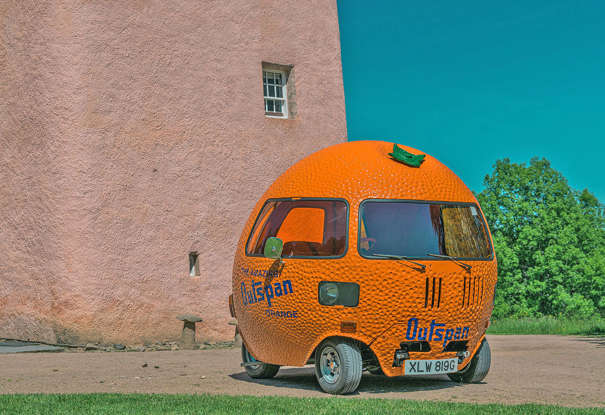1968 Oldsmobile/American Quality Coach Jetway 707
Flying was glamorous and exclusive in the 1960s, and the journey started well before you got on the plane. At least that was the theory, triggering the creation of all manner of very large and often outlandish ‘airport cars’, of which the Jetway 707 is perhaps the epitome.
Instead of being based on a station wagon or limo, its creators started with an Oldsmobile Toronado personal car instead. Still, the Toronado’s stand-out feature, its front-wheel-drive architecture, did make a certain amount of sense to making a limousine, but there was still a heck of a lot of work to do to make this 28-foot-long behemoth capable of carrying 12 to 15 people. 52 were made, and a handful survive today.
Glenfrome Facet
The Bristol-based customiser firm Glenfrome built an array of interesting cars in the ‘80s, including elongated versions of the Jaguar XJ and Mercedes S-class. But it’s probably most famous for a 7-door stretched Range Rover, and then the Facet, also based on the British luxury 4x4.
Designed in an extreme way to catch the attention like nothing else, it targeted the Middle East market and combined a targa roof with various fibreglass body panels. It was enormously expensive - £55,000 in 1983 at a time when that was the average house price in London - but a vaguely impressive 50 examples found homes nonetheless.
Tatra T77
Strange in appearance it may be to today’s eyes, Czechoslovakia’s Tatra T77 must have looked unworldly when it first emerged in 1934, standing out as one of the very first cars designed with aerodynamics in mind. It featured a rear-mounted 3.0-litre V8 good for 60bhp, though this was later boosted to 75bhp. Heavily influenced by aircraft technology – planes being the big new thing at the time – it would in turn be a major influence on the Volkswagen Type 1 ‘Beetle’.
However, while the German car would go onto sell 21.5 million examples, the expensive T77 cracked just 106 sales from 1934 to 1936, and just a handful survive today; one sold at a US auction in March 2023 for $390,000.
Oeuf electrique
When the Germans conquered France in 1940 they promptly stole most of the country’s cars – and deprived those they didn’t of petrol. Multi-disciplined industrial designer Paul Arzens came up with this response: a minimalist egg-shaped car made of aluminium and Plexiglass, powered by electricity, delivered via five 12-volt batteries.
Its 350kg weight helped to give it a vaguely impressive range of 60 miles or so, and a top speed of 43mph. It didn’t catch on, and just the single examples made, used by Arzens until his death in 1990.
Peel P50
Made by the Peel Engineering Company on the Isle of Man, the three-wheeled P50 came in red, white or blue. Originally built between 1962 and 1965 (around 50 were made), it featured a 49cc DKW single-cylinder engine good for 4.2hp and a top speed of 37mph. No reverse gear was available.
In 2011 it was revived: a petrol version now has a 49cc Honda moped engine offering a heady 4.8bhp via a CVT, but a lower top speed of 28mph. The electric version is slightly less powerful and offers a 20-mile range which in a normal EV would be tiresome but not, we expect, in a car like this. Priced around £15,000, they’ve been exported all over the world and buyers reputedly include the famous ‘Rainbow Sheikh’ car collector based in Abu Dhabi.
Cadbury’s Creme Egg car
Rather more durable and decidedly less munchable than the chocolate product it advertises, the Creme Egg car was commissioned by chocolate maker Cadbury-Schweppes in the late 1980s. It’s based on a Bedford Rascal van and five were built, their ovoid forms resembling a less healthy version of the Outspan Mini. Corgi Toys makes a model of the car that, slightly disappointingly, proves inedible.
Toyota i-Road (2013)
Building a tandem seater car is a good way to stand out from the crowd, but Toyota went much further with its i-Road at the 2013 Geneva Motor Show. As well as the 1+1 seating design, the i-Road was a mere 90cm wide, making it as narrow as most motorcycles. This was to give the car city-busting manoeuvrability and it also had leaning suspension like a motorbike’s to aid stability.
Inside, the cabin was slung for two but quiet thanks to electric power that gave a range of up to 30 miles on a single charge. Toyota planned to let the residents of Grenoble in France use the i-Road as part of a vehicle sharing experiment. The i-Road made up part of a 70-strong fleet of electric vehicles used in the three-year study.
Outspan Orange
Designed and built by the Brian Thwaites company of Sussex between 1972 and 1974, these cars were used by South African orange producer Outspan to promote its fruit around Europe. The company is still in business today, and at least three of the Oranges are known to survive, one still with Outspan. Underneath is a Mini, whose mechanical layout lent itself well to reconfiguring bodywork.
Amphicar
The Amphicar is unique in this feature in that it had presidential approval. 3878 were built in Germany by this semi-sibling firm of BMW between 1961 and 1968. Powered by a rear-mounted 1.1-litre Triumph Herald engine good for 43bhp, it could do 70mph on land and 8mph on water. Lyndon Johnson owned one and would terrify passengers by pretending the brakes had failed before driving into a lake at his ranch in Texas.



























No comments:
Post a Comment